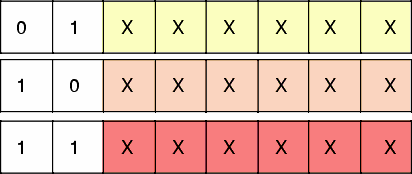
| <<< Variable-length Opcodes, Cont. | Index | Example: Two-byte Opcodes >>> |
Assume that two high-order bits of an imaginary opcode are not 00, and the opcode size is strictly one byte long.
The 6-bit field marked xxxxxx provides 26 = 64 unique bit patterns.
Together with three non-zero high-order combinations (01, 10, and 11), 192 different one-byte instructions can be encoded:
64 × 3 = 192

| <<< Variable-length Opcodes, Cont. | Index | Example: Two-byte Opcodes >>> |